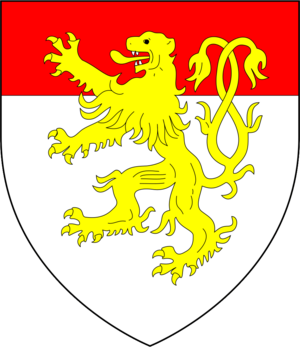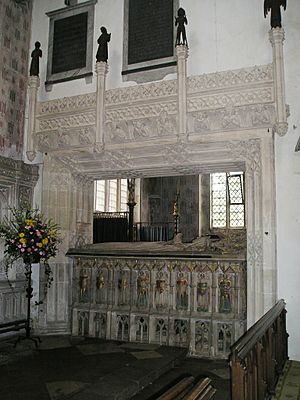Alice Chaucer, Duchess of Suffolk facts for kids
Quick facts for kids Alice Chaucer |
|
|---|---|
| Duchess of Suffolk | |
| Alice de la Pole, detail from her effigy in Ewelme Church, Oxfordshire | |
| Spouse(s) | Sir John Phelip Thomas Montagu, 4th Earl of Salisbury William de la Pole, 1st Duke of Suffolk |
| Issue | |
| John de la Pole, 2nd Duke of Suffolk | |
| Father | Thomas Chaucer |
| Mother | Matilda Burghersh |
| Born | c. 1404 |
| Died | 1475 |
| Burial | St Mary's Church, Ewelme |
Alice Chaucer, Duchess of Suffolk, a special member of the Order of the Garter (born around 1404, died 1475), was the granddaughter of the famous English poet Geoffrey Chaucer. She was married three times. Alice became a Lady of the Most Noble Order of the Garter. This was a rare honor for women. It showed the close friendship between her, her third husband William de la Pole, 1st Duke of Suffolk, and King Henry VI and his wife Margaret of Anjou.
Contents
Who Was Alice Chaucer?
Alice Chaucer was born around the year 1404. Her father was Thomas Chaucer and her mother was Matilda Burghersh. Her grandfather was Geoffrey Chaucer, who wrote the famous book The Canterbury Tales.
Alice's Marriages and Family
Alice married three times in her life:
- First, when she was about 11 years old, she married Sir John Phelip (who lived from about 1380 to 1415). They lived at Donnington Castle for a short time. Sir John sadly died less than a year later. He passed away after a battle in France.
- Second, after 1421, Alice married Thomas Montagu, 4th Earl of Salisbury (1388–1428). He was an important English military leader during the Hundred Years' War. He died during the Siege of Orléans in France.
- Third, in 1430, she married William de la Pole, 1st Duke of Suffolk (1396–1450). William was a very important advisor to King Henry VI. He was also in charge of Wallingford Castle in 1434. Alice and William had one son:
- John de la Pole (1442–1492). John later married Elizabeth of York. This made him the brother-in-law of two kings, Edward IV and Richard III. John became the 2nd Duke of Suffolk in 1463.
Alice's Important Role
Alice was a lady-in-waiting to Queen Margaret of Anjou in 1445. This meant she was an important helper and companion to the Queen.
Alice as an Art Lover
Alice loved art and supported artists. She asked for a series of beautiful tapestries to be made. These tapestries showed the life of St Anne. St Anne was the mother of the Virgin Mary and grandmother of Jesus. Alice displayed these tapestries in her home at Ewelme in Oxfordshire. This was the room where she welcomed visitors.
Alice lived at Ewelme for ten years after her husband died. She was the lady of the house and ordered these artworks. Alice was a rare and important example of a woman who supported art. She chose art that showed strong historical female characters. St Anne was a popular saint for women. Like Alice, St Anne also had three marriages.
Alice was a very smart woman. Her life shows us a lot about what life was like for women in the late Middle Ages. She had a very large library of books. Her library had many French books. She likely got these when she traveled to France with her husband. She also owned many religious books.
Alice as a Widow
After her husband William was killed, Alice became a very powerful woman. She worked hard to protect her son John's inheritance. She owned a lot of land in many different counties.
In 1450, William de la Pole was forced to leave England. On his journey, his ship was stopped. He was killed and his body was found on the beach at Dover. Alice had her husband buried at the Kingston Charterhouse.
After William's death, Alice took control of his properties. This included Wallingford Castle. She even lent a lot of money to the King. This helped her family keep their titles and lands. Alice faced many challenges but managed to keep her important position. She was in charge of Wallingford Castle until at least 1471. She might have been in charge until she died in 1475.
Alice also became the guardian of Queen Margaret of Anjou in 1472. Margaret had been her friend before. Alice was a very rich landowner. She owned land in 22 counties. She also supported the poet John Lydgate.
Death and Burial
Alice Chaucer died in 1475. She was buried in St Mary's Church in Ewelme. Her tomb is very special and still there today.
Her tomb is made of alabaster stone. It has a statue of Alice lying on top. Below the statue, you can see a sculpted image of her skeleton. This was a common style for tombs back then.
Queen Victoria's advisors even studied Alice's tomb. They wanted to see how a lady should wear the Order of the Garter. Alice wears it on her left wrist in her statue. The Latin words on her tomb say: "Pray for the soul of the Most Serene Princess Alice, Duchess of Suffolk, patron of this church, and first founder of this charity, who died on the 20th day of May in the year 1475." She was called "Most Serene Princess" because her son married into the royal family.
Her tomb also has sixteen shields with family symbols. These include the symbols of Chaucer, the Royal Arms of England, de la Pole, and Montagu families.
Alice's Grandsons and the Throne
Alice's son, John de la Pole, 2nd Duke of Suffolk, married Elizabeth of York. Elizabeth was the sister of two kings, Edward IV and Richard III.
Three of Alice's grandsons (John de la Pole's sons) tried to claim the throne against King Henry VII.
- John de la Pole, 1st Earl of Lincoln, was supposed to be King Richard III's heir. He fought against Henry VII. He supported someone who pretended to be a prince, Lambert Simnel. John was killed in a battle in 1487.
- Lincoln's younger brother, Edmund de la Pole, 3rd Duke of Suffolk, also tried to claim the throne. He was executed in 1513.
- Richard de la Pole, their youngest brother, continued the claim to the throne. He was killed in a battle in 1525.
|



